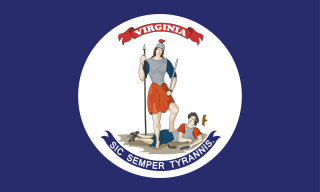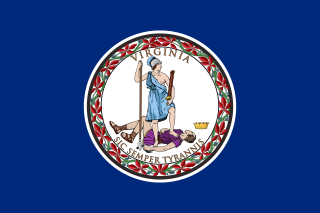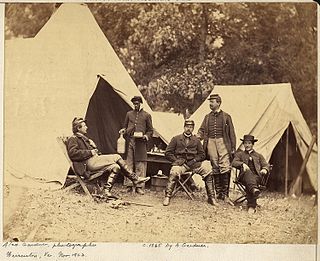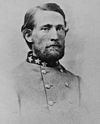
John Singleton Mosby, also known by his nickname "Gray Ghost", was an American military officer who was a Confederate cavalry commander in the American Civil War. His command, the 43rd Battalion, Virginia Cavalry was a partisan ranger unit noted for its lightning-quick raids and its ability to elude Union Army pursuers and blend in with local farmers and townsmen. The area of northern central Virginia in which Mosby operated with impunity became known as Mosby's Confederacy.

The American Civil War saw extensive use of horse-mounted soldiers on both sides of the conflict. They were vital to both the Union Army and Confederate Army for conducting reconnaissance missions to locate the enemy and determine their strength and movement, and for screening friendly units from being discovered by the enemy's reconnaissance efforts. Other missions carried out by cavalry included raiding behind enemy lines, escorting senior officers, and carrying messages.

John W. Mobberly, also known as John Mobley or Morbly, was a Confederate guerrilla who operated in the Loudoun Valley and Between the Hills region of Loudoun County, Virginia during the American Civil War. He also served as regular soldier in Elijah V. White's 35th Battalion, Virginia Cavalry, nicknamed the "Comanches." Mobberly is sometimes reported as serving under John Mosby, although this is not grounded in fact. His legacy is surrounded in controversy as Federal soldiers and Union sympathizers in Loudoun County accused him of committing war atrocities, including slave-rustling, while pro-Southern Loudoun residents claimed him to be a hero, second only to Mosby in local popularity.
Loudoun County, Virginia, was destined to be an area of significant military activity during the American Civil War. Located on Virginia's northern frontier, the Potomac River, Loudoun County became a borderland after Virginia's secession from the Union in early 1861. Loudoun County's numerous Potomac bridges, ferries and fords made it an ideal location for the Union and Confederate armies to cross into and out of Virginia. Likewise, the county's several gaps in the Blue Ridge Mountains that connected the Piedmont to the Shenandoah Valley and Winchester were of considerable strategic importance. The opposing armies would traverse the county several times throughout the war leading to several small battles, most notably the Battle of Ball's Bluff.

The Loudoun Rangers, also known as Mean's Rangers for their commander, Samuel C. Means, was a partisan cavalry unit raised in Loudoun County, Virginia, that fought for the Union during the American Civil War. The Rangers have the distinction of being the only unit raised in present-day Virginia to serve in the Union Army.

Adam Rankin "Stovepipe" Johnson was an antebellum Western frontiersman and later an officer in the Confederate States Army during the American Civil War. Johnson obtained fame leading the Newburgh Raid using a force of only about 35 men. Johnson and his men confiscated supplies and ammunition without firing a shot by deceiving Newburgh's defenders into thinking Confederate cannons surrounded the town. In reality, the "cannons" were an assemblage of a stove pipe, a charred log, and wagon wheels, forever giving Johnson the nickname of Adam "Stovepipe" Johnson. Permanently blinded during an 1864 skirmish, in 1887, Johnson founded the town of Marble Falls, Texas, which became known as "the blind man's town."

McNeill's Rangers was an independent Confederate military force commissioned under the Partisan Ranger Act (1862) by the Confederate Congress during the American Civil War. The 210 man unit was formed from Company E of the 18th Virginia Cavalry and the First Virginia Partisan Rangers. After the repeal of the Act on February 17, 1864, McNeill's Rangers was one of two partisan forces allowed to continue operation, the other being 43rd Battalion Virginia Cavalry. Both of these guerrilla forces operated in the western counties of Virginia and West Virginia. The Rangers were known to exercise military discipline when conducting raids. However, many Union generals considered Captain John Hanson McNeill (1815–1864) and his men to be "bushwhackers," not entitled to protection when captured, as was the case with other prisoners of war.
The Battle of Loudoun Heights was a small cavalry skirmish during the American Civil War between John Mosby's Rangers and Major Henry A. Cole's 1st Potomac Home Brigade Maryland Cavalry on January 10, 1864, in Loudoun County, Virginia. Cole's Cavalry successfully defended a night raid against their camp on Loudoun Heights. The fight was one of the first engagements in which Union forces held their own against Mosby's vaunted partisans.

The 35th Virginia Cavalry Battalion, also known as White's Battalion, White's Rebels and the Comanches, was a Confederate cavalry unit during the American Civil War raised by Elijah V. White in Loudoun County, Virginia in the winter of 1861-62. The battalion was initially raised as border guards along the Potomac River below Harpers Ferry but were ultimately mustered into regular service as part of the Laurel Brigade. Despite this, they continued to play a conspicuous role in the ongoing partisan warfare in Loudoun throughout the war. The battalion was particularly notable during the 1863 Gettysburg Campaign, when it played a prominent role in the Battle of Brandy Station and subsequently conducted a series of raids on Union-held railroads and defensive positions in Maryland and Pennsylvania. The 35th was the first Confederate unit to enter Gettysburg, Pennsylvania.

Blazer's Scouts was a Scout Dragoon unit of the Union Army during the second half of the American Civil War. They were particularly active in tracking down and confronting Confederate States Army partisans and guerrillas in West Virginia and Virginia; especially those of Colonel John S. Mosby. They specialized in anti-guerrilla warfare, counterinsurgency, dragoon style sudden attacks, hit-and-run, reconnaissance and scouting for gathering intelligence in enemy areas, and tracking targets hunt.

Guerrilla warfare was waged during the American Civil War (1861–1865) by both sides of the conflict, but most notoriously by the Confederacy. It gathered in intensity as the war dragged.
The Fight at Aldie was a small cavalry skirmish between Confederate forces under Major John S. Mosby and Union forces under Major Joseph Gilmore and Captain Franklin T. Huntoon in Aldie, Virginia, on March 2, 1863, as part of Mosby's Operations in Northern Virginia during the American Civil War. The fight which resulted in a Confederate victory was significant in that it was the first action of Mosby's Rangers within their operating territory in the central Loudoun Valley. In the fight Mosby and his men displayed many characteristics that would become their hallmark including the attack on numerically superior force while inflicting disproportionate casualties to those received.
The George's Schoolhouse Raid was a Confederate partisan raid led by local guerrilla John Mobberly on the Union garrison at Lovettsville in Loudoun County, Virginia on January 17, 1865, during the American Civil War. The raid was tactically inconclusive. After surprising the sleeping garrison, the Confederates were driven away by superior force, taking with them only a few horses and prisoners. The raid is notable for being the last partisan action in Loudoun County involving Elijah V. White's 35th Battalion of Virginia Cavalry.

The 18th Virginia Cavalry Regiment was a cavalry regiment raised in Virginia for service in the Confederate States Army during the American Civil War. It fought with the Army of Northern Virginia, in southwest Virginia, and in the Shenandoah Valley.

Timeline of Fauquier County, Virginia in the Civil War

John D. Read, also referred to as John Reed or John Reid, was an American abolitionist and lay preacher in Falls Church, Virginia, in the years prior to and during the American Civil War. Read was taken prisoner by Confederate partisans from Mosby's Rangers during a surprise raid on the town on October 18, 1864, and executed later that day near Vienna, Virginia.

The Warrenton Junction Raid was a surprise attack by Confederate guerrilla warriors on a Union cavalry detachment during the American Civil War. The raid took place near a railroad junction in Virginia's Fauquier County, less than 10 miles (16 km) from the town of Warrenton. Confederate Major John S. Mosby led the attack against about 100 men from the Union's 1st (West) Virginia Cavalry. At first, the raid was very successful, as many of the Union soldiers surrendered to the rebels. The remaining portion of the surprised force was surrounded in a house, and two of their leaders were wounded. The house was set on fire, and the Union soldiers surrendered. As Mosby's men rounded up prisoners and horses, a detachment of the 5th New York Cavalry surprised the rebels and rescued most of the captured Union soldiers. After a short fight, more men from the 5th New York, and the 1st Vermont Cavalry, joined in the pursuit of Mosby's fleeing rebels.
The 4th Mississippi Cavalry Regiment was a cavalry unit of the Confederate States Army in the Western Theater of the American Civil War. The 4th Regiment was formed by combining various cavalry companies into one consolidated regiment in the autumn of 1862. The 4th Cavalry fought in numerous battles in Mississippi and Louisiana before surrendering at the close of the war in May 1865.
The 56th Alabama Cavalry was a Confederate Partisan Ranger cavalry regiment from Alabama. Initially organized as 2 separate Partisan Ranger battalions, the 56th Regiment was created in the summer of 1863 and took part in several campaigns of the Western Theater of the American Civil War before surrendering in the spring of 1865.
The 1st Mississippi Partisan Rangers was a unit of the Confederate Army from Mississippi. The 1st Partisans operated as a cavalry regiment in North Mississippi and Tennessee, but suffered serious setbacks in late 1862 that compromised its effectiveness as a unit. Reorganized as the 7th Mississippi Cavalry Regiment in 1864, the regiment surrendered at the close of the war in May, 1865.

























